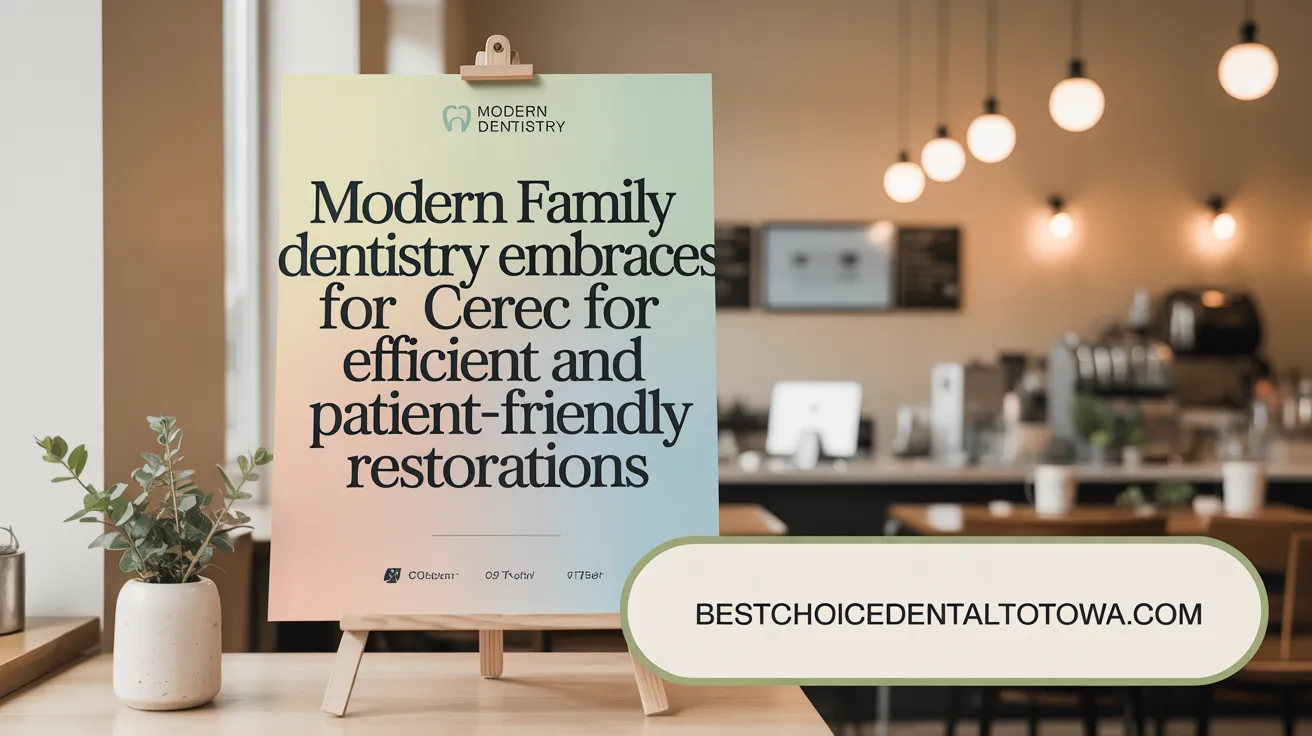An Overview of CEREC Crowns and Their Role in Modern Dentistry
Understanding CEREC Technology
CEREC, which stands for Chairside Economical Restoration of Esthetic Ceramics, is an advanced dental technology that revolutionizes how ceramic dental restorations are created and placed. Utilizing cutting-edge CAD/CAM technology, dentists can design, mill, and fit crowns, veneers, inlays, and onlays—all within a single appointment. This innovation eliminates the traditional wait time associated with lab-fabricated restorations.
Benefits of Same-Day Dental Restorations
One major advantage of CEREC technology is the convenience it provides. Patients receive high-quality, tooth-colored ceramic restorations that blend naturally with existing teeth, typically in about one to two hours. This means no temporary crowns or multiple visits are necessary, reducing discomfort and time spent at the dental office.
Additionally, digital impressions replace the need for messy putty molds, enhancing patient comfort and precision. CEREC restorations are durable, often lasting between 10 to 15 years with proper care, making them a reliable and aesthetically pleasing option for many patients.
Together, these features make CEREC an excellent choice for modern, personalized dental care focused on convenience, comfort, and lasting results.
Understanding CEREC Technology: How It Works

What is CEREC technology and how does it function?
CEREC stands for Chairside Economical Restoration of Esthetic Ceramics. This innovative dental technology uses CAD/CAM systems to create ceramic restorations such as crowns, veneers, inlays, and onlays. What makes CEREC especially beneficial is its ability to complete the entire process in a single dental appointment—from design and milling to final placement—eliminating the need for multiple visits.
How does the same-day design, milling, and placement process work?
The process begins with a digital impression of the patient's tooth using an intraoral scanner. This digital image allows the dentist to design a restoration tailored precisely to the patient's tooth shape, size, and color using CAD software. Once the design is finalized, a custom milling machine carves the restoration from a solid block of ceramic right in the dental office. After milling, the restoration is polished and carefully placed on the tooth during the same visit, providing immediate results and enhanced convenience.
What materials are CEREC crowns made from?
CEREC crowns are crafted from high-quality, tooth-colored ceramic materials formulated to closely mimic the natural look of real teeth. This ceramic is durable, resistant to wear, and biocompatible, making it a safe and long-lasting option. The materials are designed not just for strength but also for a natural aesthetic, allowing restorations to blend seamlessly with surrounding teeth.
Benefits of CEREC Crowns for Patients and Dentists

What are the main advantages of CEREC crowns compared to traditional crowns?
CEREC crowns provide significant advantages by enabling same-day ceramic dental restorations, typically completed within 60 to 90 minutes. This eliminates the need for multiple visits to the dentist, a common requirement with traditional crowns that can take weeks to complete. By fabricating and placing the crown in a single appointment crown placement, patients enjoy greater convenience and time savings. Additionally, CEREC crowns remove the necessity for temporary crowns, which can sometimes be uncomfortable or ill-fitting.
How do digital impressions improve patient experience?
CEREC technology utilizes advanced digital impressions with intraoral scanners to capture precise images of the teeth. This digital impression process is far more comfortable compared to traditional putty-based methods that many patients find unpleasant. Not only does this make the visit easier, but the digital data enhances accuracy in crown design. A precise fit reduces adjustment needs and increases the success and longevity of the restoration.
What aesthetic and durability advantages do CEREC crowns offer?
The crowns are crafted from tooth-colored porcelain CEREC crowns and custom ceramic crowns and veneers that closely mimic the natural appearance of teeth. This ensures a seamless blend with surrounding teeth, making them suitable for both front and back teeth restorations. These ceramic materials are also durable and natural-looking CEREC crowns, typically lasting between 10 and 15 years with proper oral care. Being metal-free, CEREC crowns reduce risks of allergies or sensitivities and maintain a natural translucency that enhances smile aesthetics.
How does reduction in treatment time benefit patients and dentists?
By reducing the treatment time from multiple appointments over weeks to a single appointment, CEREC crowns increase patient satisfaction and convenience. Dentists benefit from streamlined workflows and can accommodate more patients efficiently. This faster turnaround improves treatment acceptance and supports comprehensive dental care with less disruption to patients' daily lives.
Limitations and Considerations in Using CEREC Crowns

Are there any limitations to CEREC crowns?
CEREC crowns offer many advantages, especially in convenience and aesthetics, but they do have some limitations. While made from durable ceramic material, CEREC crowns are generally not as strong as traditional crowns made from metal or porcelain-fused-to-metal. This can impact their suitability for patients whose teeth endure heavy biting forces or grinding. For a detailed comparison, see CEREC Crowns vs Traditional Lab-Made Crowns.
Suitability for different types of dental cases
CEREC crowns work well for many restorative needs, including single crowns on front or back teeth. However, teeth with extensive damage below the gum line or those requiring complex restoration may benefit from traditional crowns. Traditional crowns offer a wide variety of materials and design options that better accommodate such challenging cases. For insights on limitations and suitability, visit CEREC Crown Limitations.
Material strength compared to traditional crowns
Traditional crowns, particularly those involving metal or layered materials, have a proven track record of strength and longevity in demanding dental situations. CEREC's all-ceramic crowns blend well and last 10 to 15 years with proper care but might not withstand extreme stress as effectively, as noted in CEREC crowns lasting 10 to 15 years. For a thorough comparison, see Are CEREC Crowns as Good as Traditional Crowns?.
Cases where traditional crowns may be preferred
When a tooth has severe structural damage, or when extra durability is critical, dentists may recommend traditional lab-made crowns. These are often chosen for molars subjected to intense chewing forces or teeth that require more intricate customization beyond what in-office milling machines can provide. For more details on material options and advantages, visit Benefits of same-day dental crowns and Traditional crowns advantages.
Ultimately, patient-specific factors and the dentist's evaluation determine the best restoration type to ensure long-lasting oral health and function.
Integration of CEREC Technology in Family-Oriented Dental Practices

How are family dental practices incorporating CEREC technology?
Many family dental practices, especially those in Totowa, New Jersey, have embraced advanced dental technologies to enhance patient care. These offices offer CEREC crowns—same-day ceramic dental restorations created using CAD/CAM dental restoration technology—alongside digital x-rays in dentistry and digital impressions with intraoral scanners. This combination allows for precise, efficient, and comfortable treatments tailored for patients of all ages.
Availability of CEREC crowns in modern dental offices
CEREC technology enables dental professionals to design, mill, and place custom tooth-colored porcelain CEREC crowns in a single appointment, typically lasting about one to two hours. This convenience eliminates multiple visits and the need for temporary crowns, improving patient experience and satisfaction. Local dental practices such as Keystone Dentistry in Totowa offer this cutting-edge service, ensuring that both children and adults benefit from durable and natural-looking restorations.
Advancement in family dental care
Family-focused dental clinics utilize CEREC alongside other innovative tools such as low radiation dental imaging and digital X-rays and 3D imaging to deliver comprehensive care. These technologies provide detailed diagnostics and support early intervention, which is crucial for maintaining long-term oral health. Practices also emphasize personalized treatment plans that address the unique needs of each family member, from pediatric patients to seniors.
Examples of dental practices utilizing advanced tech alongside CEREC
Totowa Dental Spa & Implant Center and Dental Arts of Totowa are prime examples of clinics combining CEREC technology with a range of services such as Invisalign, veneers, implants, and emergency care. Their use of advanced digital planning and scanning tools enhances treatment precision, comfort, and outcomes, underscoring their commitment to modern, patient-friendly dentistry.
By integrating CEREC crowns within a broader spectrum of digital and restorative advancements, family dental practices in communities like Totowa are setting new standards for efficient, comfortable, and personalized dental care.
Maintaining and Caring for CEREC Crowns to Maximize Longevity

How long do CEREC crowns last and how should patients care for them?
CEREC crowns generally have a lifespan of 10 to 15 years when properly maintained. These durable ceramic restorations, designed to blend seamlessly with your natural teeth, require attentive care to stay strong and attractive over time.
To maximize the longevity of your CEREC crown, follow these care recommendations:
- Maintain excellent oral hygiene by brushing twice daily and flossing regularly to prevent plaque buildup around the crown.
- Avoid biting or chewing on hard objects like ice or pens, which could chip or damage the ceramic material.
- Limit consumption of sticky foods that might loosen the crown.
- Attend routine dental exams and professional cleanings so your dentist can monitor the crown's condition and address any issues early.
Patient education is essential, and dentists use digital imaging and CAD/CAM precision technology to show exact crown placement and explain personalized care tips. Adopting these habits helps ensure your crown remains comfortable, durable, and natural-looking for many years.
Regular professional guidance combined with consistent home care is the best strategy to keep your CEREC restoration functional and attractive.
